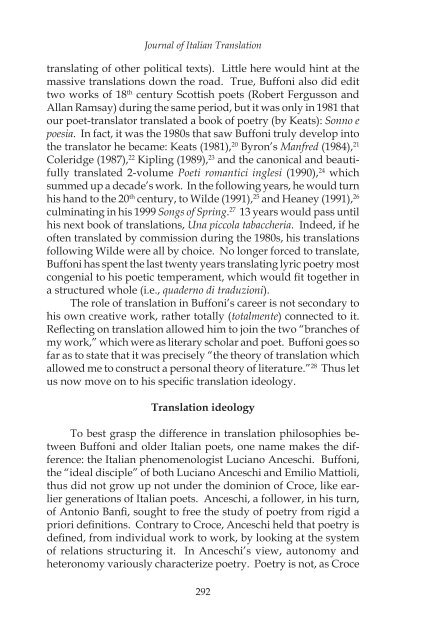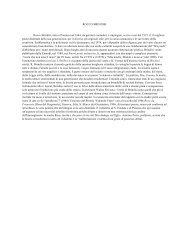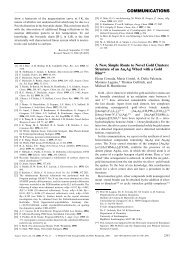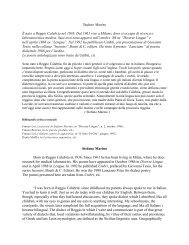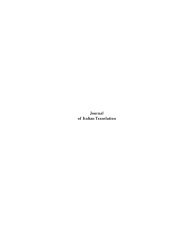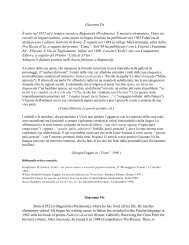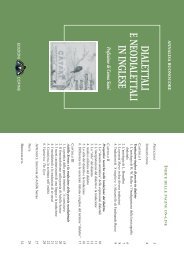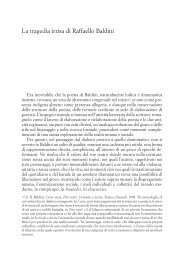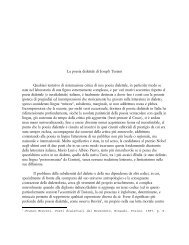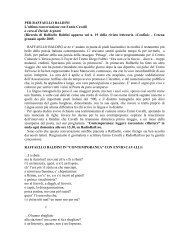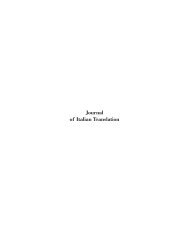- Page 2 and 3:
Journal of Italian Translation
- Page 4 and 5:
Journal of Italian Translation Edit
- Page 6 and 7:
La presenta Alessandro Parrochi su
- Page 8 and 9:
Altre contrade Sono andato a trovar
- Page 10 and 11:
Journal of Italian Translation Volu
- Page 12 and 13:
Franco Buffoni: The Poietic Encount
- Page 14 and 15:
Translations
- Page 16 and 17:
Poems by Francesca Turini Bufalini
- Page 18 and 19:
Joan E. Borrelli / Francesca Turini
- Page 20 and 21:
Le ginestre, 1979.
- Page 22 and 23:
Joan E. Borrelli / Francesca Turini
- Page 24 and 25:
Marisa Marcelli Poems in dialect an
- Page 26 and 27:
1 Poems in the Old Dialect of Gioio
- Page 28 and 29:
3 Luigi Bonaffini / Marisa Marcelli
- Page 30 and 31:
Luigi Bonaffini / Marisa Marcelli w
- Page 32 and 33:
Luigi Bonaffini / Marisa Marcelli 7
- Page 34 and 35:
Luigi Bonaffini / Marisa Marcelli *
- Page 37 and 38:
Journal of Italian Translation with
- Page 39 and 40:
Journal of Italian Translation Jack
- Page 41 and 42:
Journal of Italian Translation Agat
- Page 43 and 44:
Journal of Italian Translation List
- Page 45 and 46:
Journal of Italian Translation Nove
- Page 47 and 48:
La foresta di Birnam, 1980.
- Page 49 and 50:
Journal of Italian Translation INED
- Page 51 and 52:
Dio non parla, è un poco divino di
- Page 53 and 54:
Journal of Italian Translation Le s
- Page 55 and 56:
Le ginestre, 1982.
- Page 57 and 58:
Journal of Italian Translation Gran
- Page 59 and 60:
Journal of Italian Translation Wher
- Page 61 and 62:
Journal of Italian Translation You
- Page 63 and 64:
Luciano Somma Cristo Napulitano (Ne
- Page 65 and 66:
Journal of Italian Translation for
- Page 67 and 68:
Journal of Italian Translation Ches
- Page 69 and 70:
Journal of Italian Translation DOCE
- Page 71 and 72:
Journal of Italian Translation L’
- Page 73 and 74:
Journal of Italian Translation Stu
- Page 75 and 76:
Journal of Italian Translation e nu
- Page 77 and 78:
Journal of Italian Translation CORE
- Page 79 and 80:
Journal of Italian Translation “R
- Page 81 and 82:
Male di luna by Luigi Pirandello Tr
- Page 83 and 84:
Journal of Italian Translation MALE
- Page 85 and 86:
Journal of Italian Translation per
- Page 87 and 88:
Journal of Italian Translation - Ma
- Page 89 and 90:
Journal of Italian Translation parv
- Page 91 and 92:
Journal of Italian Translation - Ah
- Page 93 and 94:
Journal of Italian Translation per
- Page 95 and 96:
Journal of Italian Translation pagn
- Page 97 and 98:
Journal of Italian Translation - An
- Page 99 and 100:
Le mele d’oro, 1981.
- Page 101 and 102:
Lettera e preghiera Caro perduto Lu
- Page 103 and 104:
Journal of Italian Translation Vetr
- Page 105 and 106:
Journal of Italian Translation Lett
- Page 107 and 108:
Journal of Italian Translation agli
- Page 109 and 110:
Journal of Italian Translation * *
- Page 111 and 112:
Notturno sulla lavanda, 1979.
- Page 113 and 114:
Journal of Italian Translation IL C
- Page 115 and 116:
Journal of Italian Translation sull
- Page 117 and 118:
Journal of Italian Translation E pe
- Page 119 and 120:
Francesca Bellino’s “La fuga”
- Page 121 and 122:
La Fuga di Francesca Bellino Roma
- Page 123 and 124:
Journal of Italian Translation ha d
- Page 125 and 126:
Journal of Italian Translation la l
- Page 127 and 128:
Journal of Italian Translation in G
- Page 129 and 130:
Journal of Italian Translation mori
- Page 131 and 132:
Journal of Italian Translation Il t
- Page 133 and 134:
Journal of Italian Translation dell
- Page 135 and 136:
Fabio Scotto’s A riva Translation
- Page 137 and 138:
Journal of Italian Translation is a
- Page 139 and 140:
Journal of Italian Translation 4 A
- Page 141 and 142:
Journal of Italian Translation lega
- Page 143 and 144:
Journal of Italian Translation ling
- Page 145 and 146:
Journal of Italian Translation IL C
- Page 147 and 148:
Journal of Italian Translation scri
- Page 149 and 150:
Papaveri ai bordi della Versiliana,
- Page 151 and 152:
Giosuè Carducci (1835-1907) The fi
- Page 153 and 154:
Journal of Italian Translation Alle
- Page 155 and 156:
Journal of Italian Translation Qui
- Page 157 and 158:
Annibal diro. - Journal of Italian
- Page 159 and 160:
Journal of Italian Translation ella
- Page 161 and 162:
Journal of Italian Translation disc
- Page 163 and 164:
Journal of Italian Translation Erra
- Page 165 and 166:
Journal of Italian Translation Vedi
- Page 167 and 168:
Journal of Italian Translation paio
- Page 169 and 170:
Journal of Italian Translation sol
- Page 171 and 172:
Journal of Italian Translation O lo
- Page 173 and 174:
Journal of Italian Translation Fres
- Page 175 and 176:
Journal of Italian Translation L’
- Page 177 and 178:
Journal of Italian Translation Di c
- Page 179 and 180:
Journal of Italian Translation Anni
- Page 181 and 182:
La nebbia a gl’irti colli Piovigg
- Page 183 and 184:
Ritratto di De Chirico, 1970.
- Page 185 and 186:
Re-Creations: American Poets in Ita
- Page 187 and 188:
Journal of Italian Translation Step
- Page 189 and 190:
Journal of Italian Translation When
- Page 191 and 192:
Journal of Italian Translation A Ma
- Page 193 and 194:
Journal of Italian Translation Lead
- Page 195 and 196:
Journal of Italian Translation Dani
- Page 197 and 198:
Morning, and the mist hangs close u
- Page 199 and 200:
the charted bay, a faint ‘Halloo.
- Page 201 and 202:
Journal of Italian Translation Stil
- Page 203 and 204:
Journal of Italian Translation [rep
- Page 206 and 207:
Voices in English from Europe to Ne
- Page 208 and 209:
An award-winning poet and fiction w
- Page 210 and 211:
M.R. Sottocorona / Marco Sonzogni I
- Page 212 and 213:
M.R. Sottocorona / Marco Sonzogni m
- Page 214 and 215:
M.R. Sottocorona / Marco Sonzogni P
- Page 216 and 217:
M.R. Sottocorona / Marco Sonzogni C
- Page 218 and 219:
wireless imagination, ubiquity, lac
- Page 220 and 221:
Anna in rosso, 1977.
- Page 222 and 223:
Gianluca Rizzo and Dominic Siracusa
- Page 224 and 225:
Gianluca Rizzo and Dominic Siracusa
- Page 226 and 227:
Gianluca Rizzo and Dominic Siracusa
- Page 228 and 229:
Gianluca Rizzo and Dominic Siracusa
- Page 230 and 231:
Gianluca Rizzo and Dominic Siracusa
- Page 232 and 233:
Gianluca Rizzo and Dominic Siracusa
- Page 234 and 235:
Gianluca Rizzo and Dominic Siracusa
- Page 236 and 237:
Gianluca Rizzo and Dominic Siracusa
- Page 238 and 239:
Gianluca Rizzo and Dominic Siracusa
- Page 240 and 241:
Gianluca Rizzo and Dominic Siracusa
- Page 242: Gianluca Rizzo and Dominic Siracusa
- Page 245 and 246: Journal of Italian Translation Il c
- Page 247: Journal of Italian Translation Coff
- Page 250 and 251: Poets Under Forty (Translated by Mi
- Page 252 and 253: * the true essence of things the ar
- Page 254 and 255: * Poets Under Forty the projects of
- Page 256 and 257: * romantic springtime the sea insid
- Page 258 and 259: * nature all in gray the forms of w
- Page 260: I. Poets Under Forty KNOWN PARTS (T
- Page 263 and 264: Per il cuore di Pagliuca Premessa U
- Page 265 and 266: Journal of Italian Translation spos
- Page 267 and 268: Journal of Italian Translation appe
- Page 269 and 270: Journal of Italian Translation COR
- Page 271 and 272: Journal of Italian Translation ***
- Page 273 and 274: Journal of Italian Translation ru l
- Page 275 and 276: Stievv’ r’ quart’, arrizzicà
- Page 278 and 279: Franco Buffoni Poet and Translator
- Page 281 and 282: Journal of Italian Translation * Da
- Page 283 and 284: Journal of Italian Translation * Da
- Page 285 and 286: Journal of Italian Translation * Si
- Page 287 and 288: Franco Buffoni: the Poietic Encount
- Page 289 and 290: Journal of Italian Translation D’
- Page 291: including the previous trilogy: Jou
- Page 295 and 296: Journal of Italian Translation ers
- Page 297 and 298: Journal of Italian Translation the
- Page 299 and 300: Journal of Italian Translation titl
- Page 301 and 302: Journal of Italian Translation The
- Page 303 and 304: Journal of Italian Translation wher
- Page 305 and 306: Journal of Italian Translation Roto
- Page 307 and 308: Journal of Italian Translation Che
- Page 309 and 310: Journal of Italian Translation insi
- Page 311 and 312: Journal of Italian Translation 28 P
- Page 313 and 314: Journal of Italian Translation Scot
- Page 316 and 317: Poets Laureate of the United States
- Page 318 and 319: Autoritratto con Anna, 1977.
- Page 320 and 321: Luigi Bonaffini / Philip Levine Da
- Page 322 and 323: Luigi Bonaffini / Philip Levine Pri
- Page 324 and 325: Luigi Bonaffini / Philip Levine I m
- Page 326 and 327: Luigi Bonaffini / Philip Levine dov
- Page 328 and 329: Luigi Bonaffini / Philip Levine San
- Page 330 and 331: Luigi Bonaffini / Philip Levine men
- Page 332: Luigi Bonaffini / Philip Levine La
- Page 335 and 336: Poets of the Italian Diaspora Franc
- Page 337 and 338: sciame dorato lingotti di luce in v
- Page 339 and 340: [...] 9 Tiepide ancora le sere di q
- Page 341 and 342: Journal of Italian Translation la m
- Page 343 and 344:
santa Missina pi lavari e livàriti
- Page 345 and 346:
Journal of Italian Translation ma c
- Page 347 and 348:
Journal of Italian Translation * Nt
- Page 349 and 350:
Journal of Italian Translation GIAN
- Page 351 and 352:
Journal of Italian Translation A To
- Page 353 and 354:
Journal of Italian Translation Non
- Page 356:
New Translators Edited by John DuVa
- Page 359 and 360:
Journal of Italian Translation Il d
- Page 361 and 362:
Journal of Italian Translation S -
- Page 363 and 364:
Journal of Italian Translation S -
- Page 365 and 366:
Journal of Italian Translation mill
- Page 367 and 368:
Journal of Italian Translation Ital
- Page 369 and 370:
1977 mat 82X70.
- Page 371 and 372:
Journal of Italian Translation A te
- Page 373 and 374:
Journal of Italian Translation “A
- Page 375 and 376:
Journal of Italian Translation A Lo
- Page 377 and 378:
Journal of Italian Translation For
- Page 380 and 381:
Recensioni / Book Reviews
- Page 382 and 383:
Book Reviews E poi fioriscono tradu
- Page 384 and 385:
Book Reviews (ortografica) e la scr
- Page 386 and 387:
Book Reviews overt nostalgia in his
- Page 388 and 389:
Book Reviews Of Champagne, five hun
- Page 390 and 391:
Book Reviews deed, legendary, mythi
- Page 392 and 393:
Book Reviews trees, make it a bliss
- Page 394 and 395:
Book Reviews culture, did an estima
- Page 396 and 397:
G R A D I V A INTERNATIONAL JOURNAL


